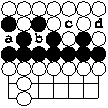1996-10-05 last update, 1996-10-05 first day, Robert
Jasiek
Copyright: All rights of the author are preserved according to the
international law.
Examples 4
Introduction
This page gives examples with comments referring to the
Basic Ko Rules. Conventions
are defined. If a whole string should have marks on it, just ignore them;
they are immaterial.
Examples

Basic ko
- a together with the point right of it is a ko. This is the only possible
ko shape by definition.
- W[aa]# is prohibited due to the basic ko rule.
- W[attatt..] is allowed.

Double ko
- Two kos a and b are on the board.
- B[aa]#, W[bb]# or B[abb]# are prohibited due to the basic ko rule.
- Conceivable board plays are limited to the union of the two kos a and
b. The rest of the board remains unchanged. This is important for the prohibition
rule. Also the set of board points of the union of all kos does not change.
- After B[abpabp] B has captured stones in a and b and W has captured
stones in a and b. Due to the prohibition rule B[abpabpa]# is prohibited.
The game ends after B[abpabpp]. The game might have better ended after
B[pp] only.

Triple ko
- Three kos a, b, c are on the board. A tenuki, that would change the
rest of the board, is not possible. The only board plays reasonably available
are ko captures. Each player can capture once in each ko. Then the prohibition
rule does not allow a further ko capture. Altogether 6 ko captures are
possible.
- The prohibition rule restricts play to W[acbacbpcpp].
- W[pcpp] gives the same result.

Three kos
- a, b, c are the three kos on the board. The union of all board points
of all kos on the board consists of the 6 board points of the 3 kos. All
other board points form the rest of the board.
- The players may decide to treat a and b as miai and to fight for c
only: B[cttctt..]
- If both players stubbornly insist on capturing stones in kos, they
will be trapped in prohibition after 6 moves: B[cbacba] and no ko capture
by either player remains untouched. The next move must be a play elsewhere:
B[cbacbat]#. This changes the rest of the board. So now stubbornness might
reappear: [..cbacba]. But only for 6 moves.

Triple ko
- B cannot capture W: After B[acbacb] the prohibition rule applies. It
is a coexistence.
- Even if a is external, but still adjacent to the big W string, it is
a coexistence.

Moonshine life
- B cannot capture W with B[abcabc] due to the prohibition rule.

Sending-2-returning-1 and bent-4
- No ko is on the board. However, repetition might occur and will be
restricted by the prohibition rule. The phrase "nor play another move
on a distinct board point" applies for repeated board positions (except
board points in kos, but here are none).
- B[acapa]#, B[bcbpb]#, B[acapbcbpa]#, and B[acapbcbpb]# are forbidden
by the prohibition rule.
- If the last stone played was the B stone on a, then also W[paca]# would
be prohibited.

Quadruple ko
- W[acbdcbdapp] leaves the position in coexistence as well as W[pp].

Ring of 4 basic kos
- This is a coexistence. Before the game end not more than 8 ko captures
will be possible.

Molasses ko
- a is the only ko on the board. During cyclical play only a and b can
become kos.
- B[cadbpcbdapdacb]# is the first prohibited move in the MS. W loses.
- B stones at c respectively d give different rests of the board. Therefore,
even tough after [..pd]# the union of all kos is only the ko a, [..pda]#
is also allowed.
Exercises

Four kos
- What will remain on the board?

At b shall be a B stone, at d shall be a W stone
Links












